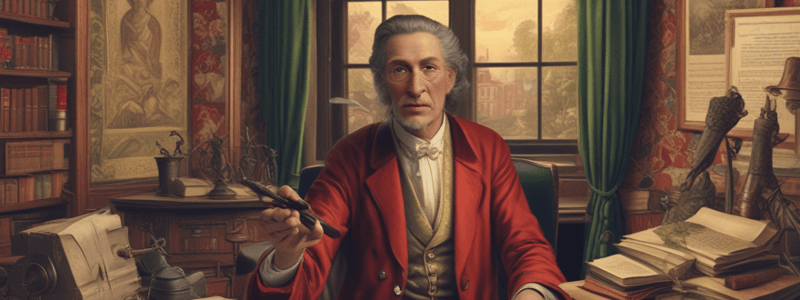Podcast
Questions and Answers
What is the primary difference between primary and secondary sources?
What is the primary difference between primary and secondary sources?
- Primary sources are interpretations of history, while secondary sources are the actual historical events.
- Primary sources contextualize events, while secondary sources provide a framework for understanding biases.
- Primary sources analyze historical context, while secondary sources discuss and evaluate evidence.
- Primary sources are written before the events in question, while secondary sources are written after. (correct)
What is a key requirement for historical analysis according to the text?
What is a key requirement for historical analysis according to the text?
- Considering only the author's perspective in historical works.
- Writing articles and scholarly works about historical events.
- Evaluating the credibility and reliability of sources. (correct)
- Ignoring biases and perspectives in historical texts.
How does historical analysis help us understand the present?
How does historical analysis help us understand the present?
- By creating new historical events to explain current issues.
- By identifying persistent patterns and trends over time. (correct)
- By distorting patterns and trends from the past.
- By ignoring historical evidence in making decisions about the future.
What is a core aspect of critical thinking in historical analysis?
What is a core aspect of critical thinking in historical analysis?
In historical analysis, what role do secondary sources play?
In historical analysis, what role do secondary sources play?
Why is constructing persuasive arguments based on evidence important in historical analysis?
Why is constructing persuasive arguments based on evidence important in historical analysis?
What is the primary goal of historical analysis?
What is the primary goal of historical analysis?
Which of the following is NOT considered a primary source in historical analysis?
Which of the following is NOT considered a primary source in historical analysis?
What is the significance of primary sources in historical analysis?
What is the significance of primary sources in historical analysis?
Which of the following is NOT a characteristic of effective historical analysis?
Which of the following is NOT a characteristic of effective historical analysis?
What is the role of critical thinking in historical analysis?
What is the role of critical thinking in historical analysis?
Which of the following statements accurately describes historical analysis?
Which of the following statements accurately describes historical analysis?
Flashcards are hidden until you start studying
Study Notes
Historical Analysis: Uncovering Hidden Truths
Historical analysis is the process of examining historical events, processes, and patterns to gain insights into the past and understand the present. It's a crucial aspect of historical research, as it enables us to discern the causes and consequences of historical phenomena, weigh competing explanations, and evaluate credible sources. In this article, we'll explore what historical analysis entails, the importance of primary sources, and how historians employ critical thinking and evidence-based arguments in their research.
The Essence of Historical Analysis
Historical analysis is a form of critical thinking that involves evaluating primary and secondary sources to construct a coherent and persuasive argument about the past. It goes beyond summarizing historical facts and delves into the whys and hows of historical events. This involves understanding the context in which events occurred, the motivations of key players, and the broader patterns and trends that shaped history.
Primary Sources: The Gateway to the Past
Primary sources are the foundation of historical analysis. They are firsthand accounts or direct evidence from the time period under study. These can include diaries, letters, speeches, government documents, and more. By analyzing primary sources, historians can gain insight into the perspectives and experiences of people who lived through the events they are studying.
Secondary Sources: The Lens Through Which We Look
Secondary sources, on the other hand, are interpretations of history written after the events in question. They can be books, articles, or other scholarly works that discuss and analyze primary sources. These sources help historians to contextualize the events they are studying and provide a framework for understanding the broader historical context.
Critical Thinking and Evidence-Based Arguments
Historical analysis requires a high level of critical thinking. Historians must be able to evaluate the credibility and reliability of sources, identify biases and perspectives, and weigh competing explanations. This involves asking questions about the sources, such as who wrote them, why they were written, and what the author's perspective might be. Historians must also be able to construct a persuasive argument based on the evidence they have gathered.
The Role of Historical Analysis in Understanding the Present
Historical analysis plays a crucial role in understanding the present by shedding light on the origins and development of current issues and trends. By examining the past, historians can identify patterns and trends that have persisted over time, helping us to better understand the present and make informed decisions about the future.
In conclusion, historical analysis is a complex and rigorous process that involves evaluating primary and secondary sources, employing critical thinking, and constructing persuasive arguments based on evidence. It is through this process that historians can uncover hidden truths and gain valuable insights into the past, which in turn helps us to better understand the present and navigate the future.
Studying That Suits You
Use AI to generate personalized quizzes and flashcards to suit your learning preferences.




